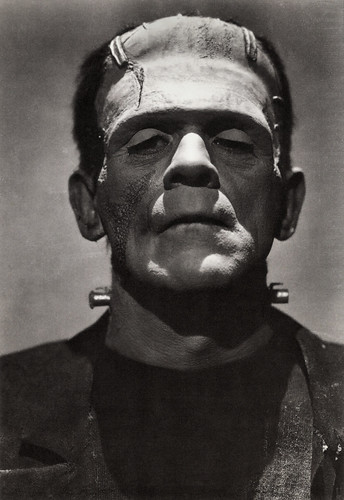
American postcard by Classico San Francisco, no. 233/06. Photo: Roman Freulich / Universal Pictures. Boris Karloff in Frankenstein (James Whale, 1931).
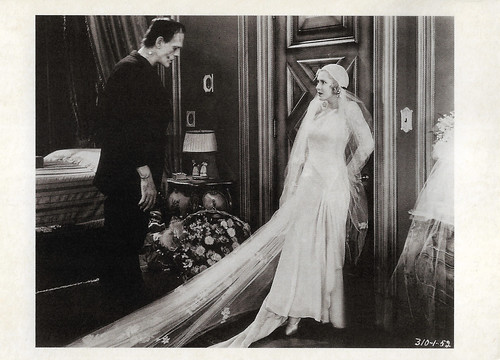
American postcard by American Postcard, no. 37. Boris Karloff and Mae Clarke in Frankenstein (James Whale, 1931).

Vintage press photo. Colin Clive and Dwight Frye in Frankenstein (James Whale, 1931).
A man made entirely of parts from corpses
For Frankenstein (1931), the Peggy Webling play was adapted by John L. Balderston and the screenplay was written by Francis Edward Faragoh and Garrett Fort, with uncredited contributions from Robert Florey and John Russell.
In a village in the Bavarian Alps, Dr Henry Frankenstein, Victor Frankenstein in the novel, (played by Colin Clive) is a brilliant scientist possessed by the idea of reviving dead tissue. To carry out his experiments, he goes out at night to dig up corpses along with his hunchback servant Fritz (Dwight Frye).
But instead of providing him with a healthy brain, Fritz gives him the brain of a murderer. Henry is about to marry his fiancée Elizabeth (Mae Clarke) to inherit his father's estate, but he increasingly loses sight of reality and becomes completely absorbed by his experiments. One stormy night, his greatest life wish is fulfilled when he uses lightning to revive his creation, a man made entirely of parts from corpses.
The creature (Boris Karloff), often known as "Frankenstein's monster", seems simple and harmless at first, meekly doing whatever Frankenstein commands, but soon Henry and Fritz begin to suspect that the creature could be dangerous and lock him in the cellar. Their fears prove well-founded when the monster breaks out and kills Fritz.
Henry realises his mistake and, helped by his old teacher Dr. Waldman (Edward Van Sloan), sets out to eliminate the monster with a lethal injection. They manage to administer the monster the injection, but it only renders the monster unconscious. As Henry goes to his wedding, the monster reawakens and kills Waldman. It then escapes from the castle. After some wandering, it meets Little Maria, a farmer's daughter (Marilyn Harris) who is not afraid of it, but in his ignorance, he throws her into the water and she drowns.
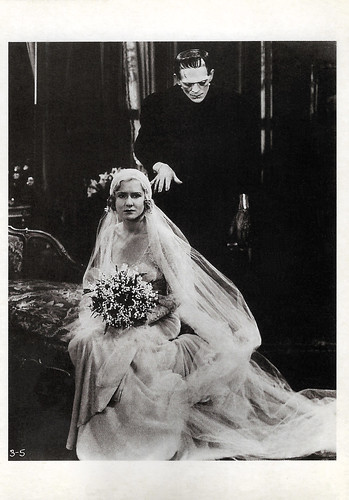
American postcard by American Postcard, no. 38. Boris Karloff and Mae Clarke in Frankenstein (James Whale, 1931).

American postcard by Zoetrope Images Ltd., Boston, no 432. Photo: Boris Karloff in Frankenstein (James Whale, 1931).
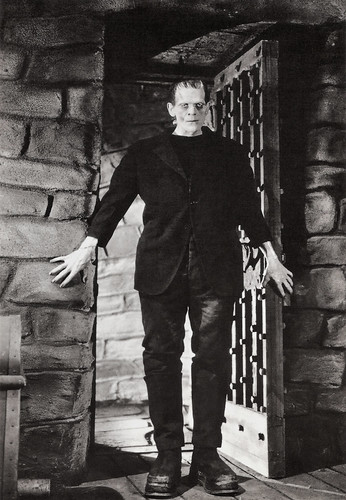
American postcard by Classico San Francisco, no. 233/01. Photo: Universal Pictures. Boris Karloff in Frankenstein (James Whale, 1931).
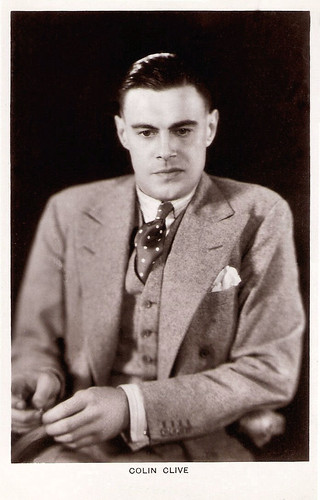
British postcard in the Picturegoer Series, London, no. 482. Colin Clive.

British postcard in the Picturegoer series, London, no 707 H. Photo: Universal. Boris Karloff.
How Dracula and Frankenstein Saved Universal
In 1930, Universal Studios had lost $2.2 million in revenues. Within 48 hours of its opening at New York's Roxy Theatre on 12 February 1931, Dracula (Tod Browning, 1931) starring Béla Lugosi had sold 50,000 tickets, building a momentum that culminated in a $700,000 profit, the largest of Universal's 1931 releases. As a result, the head of production, Carl Laemmle Jr., announced immediate plans for more horror films.
Frankenstein (1931) was initially to be directed by Robert Florey. Following his acclaimed role as Count Dracula, Béla Lugosi was Florey's first choice for the role of Dr. Frankenstein. However, when he proved unsuitable for the role, he was offered to play the monster instead so that Universal could at least include his name on the film poster.
Robert Florey shot two test reels with Lugosi in the role of the monster. Reportedly, these reels were disappointing. Universal then took Florey and Lugosi off the project. They were given Murders in the Rue Morgue, as a consolation. Lugosi would still play the monster years later in the film Frankenstein Meets the Wolf Man (Roy William Neill, 1943).
After Florey's departure, the newly arrived British director James Whale took over and he cast Colin Clive and Boris Karloff. He had the screenplay rewritten to give the monster more character. Jack Pierce came up with the familiar look for the monster. Pierce was inspired by brain operations when surgeons cut off the top of the skull. He flattened the top of the skull and added staples. Pierce covered Karloff's hair with a skullcap. He drew a square skull and forehead using cotton soaked in collodion. The actor felt that his eyes were still too bright and Pierce made wax eyelids.
Kenneth Strickfaden was responsible for the special effects surrounding the monster's creation, especially the electricity. Boris Karloff reportedly feared being burnt by the electricity in the scene. The effects were so successful that they became an essential part of every subsequent Universal film involving Frankenstein's Monster. Accordingly, the equipment used to produce them has come to be referred to in fan circles as "Strickfadens". It appears that Strickfaden managed to secure the use of at least one Tesla Coil (transformer) built by inventor Nikola Tesla himself.
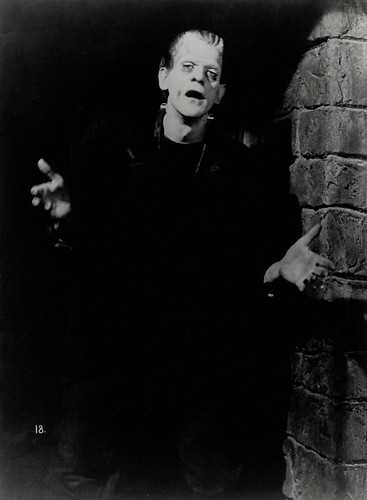
Dutch press photo by Nederlands Film Museum, Amsterdam. Boris Karloff in Frankenstein (James Whale, 1931).
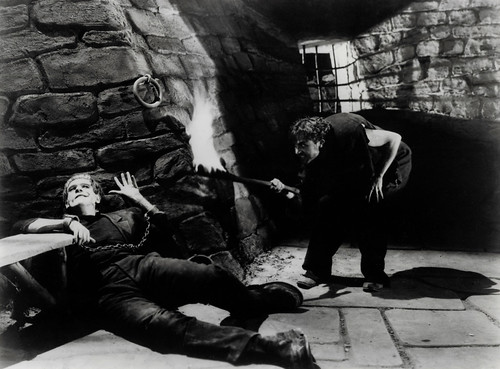
Vintage press photo. Boris Karloff and Dwight Frye in Frankenstein (James Whale, 1931).

Vintage photo. John Boles, Edward Van Sloan, Colin Clive and Boris Karloff in Frankenstein (James Whale, 1931).
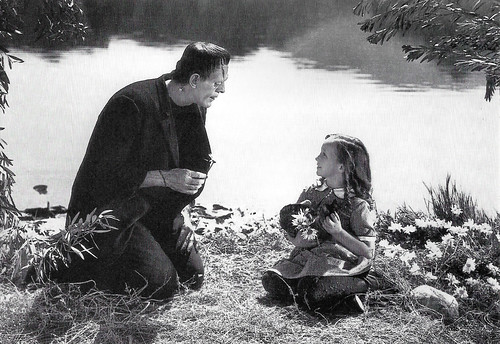
Vintage press photo. Boris Karloff and Marilyn Harris in Frankenstein (James Whale, 1931).
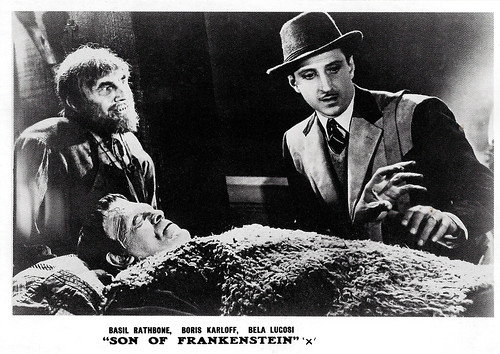
English postcard by Moviedrome, no. M7. Boris Karloff, Basil Rathbone and Béla Lugosi in Son of Frankenstein (Rowland V. Lee, 1939).
"It's alive!"
Frankenstein (James Whale, 1931) was produced with an estimated budget of $291,000. The film was a sensation. The scene in which the monster throws Little Maria into the water, accidentally drowning her, was long considered too controversial. In the states of Massachusetts, Pennsylvania, and New York, among others, the second part of this scene was cut. Cinemas in the state of Kansas wanted a total of 32 scenes removed from the film before they were willing to show it. If they had been removed, would have cut half of the film.
Frankenstein introduced several elements not found in the original book, but today closely associated with Frankenstein and his monster: Fr. Frankenstein's laboratory, the idea that Frankenstein steals the body parts for his creation from graves at night, the idea that Frankenstein uses lightning to bring his creation to life, the idea that Frankenstein would have an assistant, still called Fritz in this film but named Igor in many later films and series, Frankenstein's cry of joy "It's alive!" when the monster is successfully brought to life and the idea of an angry mob eventually armed with torches hunt down the monster.
Frankenstein was well-received by critics. The New York Times film critic Mordaunt Hall said that the film "aroused so much excitement at the Mayfair yesterday that many in the audience laughed to cover their true feelings. [T]here is no denying that it is far and away the most effective thing of its kind. Beside it Dracula is tame and, incidentally, Dracula was produced by the same firm".
People flocked to the cinema and the box office receipts amounted to $5,000,000. It was one of the biggest box office hits of the 1931-1932 period, proving to Universal Pictures executives that there was an audience for Horror films. The film had a significant impact on popular culture. The imagery of a maniacal "mad" scientist with a subservient hunchbacked assistant and the film's depiction of Frankenstein's monster has since become iconic.
In 1991, the United States Library of Congress selected Frankenstein (James Whale, 1931) for preservation in the National Film Registry as being "culturally, historically, or aesthetically significant".
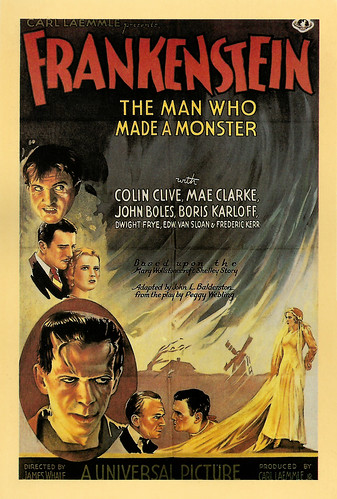
Vintage postcard by Edition Hugo, Movie Collection, no. 810. American poster by Universal for Frankenstein (James Whale, 1931).

French postcard by Editions Zreik, Paris, no. 24. Original artwork: Bos. Vintage poster for Frankenstein (James Whale, 1931).

German postcard by Edition Tushita, Cinemania, no. B806. German poster for the Universal International film Frankenstein (James Whale, 1931).

German postcard by ZigZagPosters, no. B. 016. Original artwork: Kurt Degen. German poster for Frankenstein (James Whale, 1931).

Vintage postcard by Edition Hugo, Movie Collection, no. 801. Spanish poster for Frankenstein (James Whale, 1931).
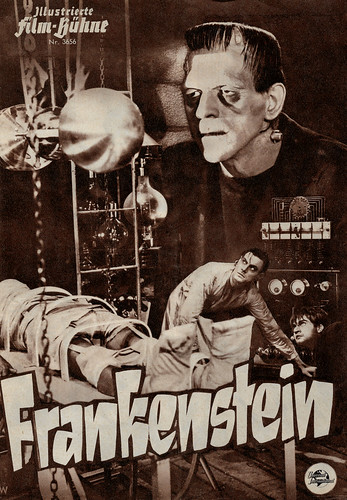
German flyer by Illustrierte Film-Bühne, no. 3656. Photo: Universal. Boris Karloff, Colin Clive and Dwight Frye in Frankenstein (James Whale, 1931).
Sources: Mordaunt Hall (The New York Times), Wikipedia (Dutch, French and English) and IMDb.
No comments:
Post a Comment